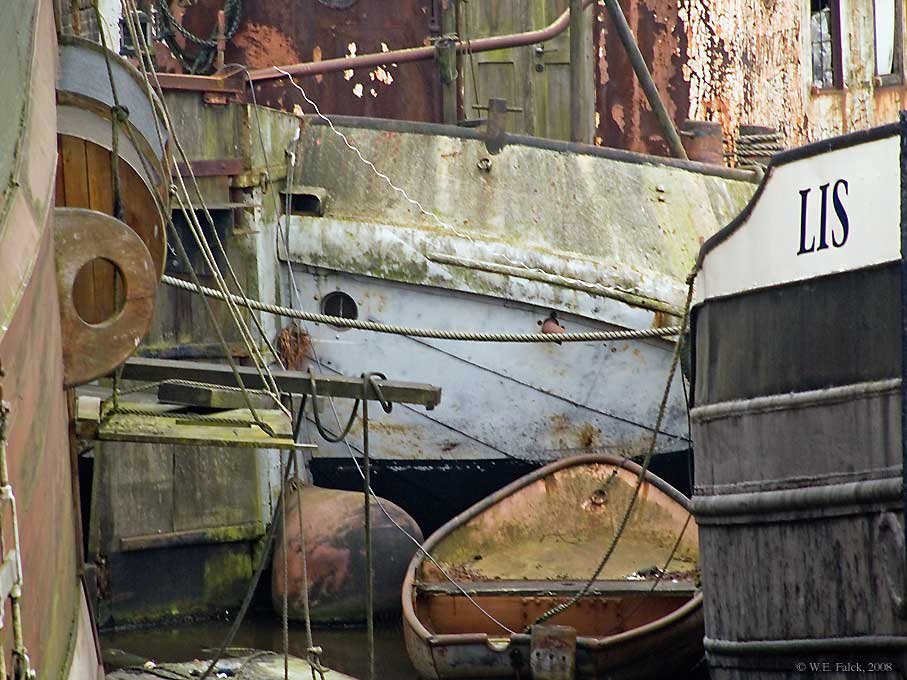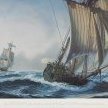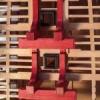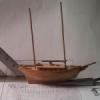Supplies of the Ship Modeler's Handbook are running out. Get your copy NOW before they are gone! Click on photo to order.
×
-
Posts
6,413 -
Joined
-
Last visited
Reputation Activity
-
 wefalck reacted to Duanelaker in The Peterboro Canoe by Duanelaker - FINISHED - Midwest Products - 1:12
wefalck reacted to Duanelaker in The Peterboro Canoe by Duanelaker - FINISHED - Midwest Products - 1:12
Quick note: DO NOT GLUE YOUR BOTTOM PLANK OR ANY PLANK TO THE FORMS, only the stems get glued to the building board. I didn’t make this mistake, but I almost did!
I the glued the stem/bottom plank assembly onto the strong back and laid down my first plank. It went on fairly easy so fingers crossed. I am also lightly sanding each of the planks as I put them on in hopes to cut down on the basswood fuzz.
-
 wefalck reacted to KeithAug in Germania Nova 1911 by KeithAug - FINISHED - Scale 1:36 - replica of schooner Germania 1908
wefalck reacted to KeithAug in Germania Nova 1911 by KeithAug - FINISHED - Scale 1:36 - replica of schooner Germania 1908
Having made the bowsprit it was time to sort out the bow rails, in particular the the infill between the rail and the bowsprit. From the photo it can be seen that the rails are cut off square at the bow end and that the space between the rail and the bowsprit is filled by an insert. This insert masks the lower half of the bowsprit hoop and the previously made staysail bracket.
I started by shaping and inserting a strengthening piece immediately below the level of the rail. The middle section of this needs to be removed so I partly cut it through with a razor saw to make the later removal easier.
I made a former to ease the creation of the rail infills.
The previously installed capping rails were cut back and the infills were then glued on to the strengthening piece / rails and the middle of the strengthening piece was removed.
I then test fitted the bowsprit.
Then took a couple of general shots:-
-
 wefalck got a reaction from Canute in WRITER’S BOAT MODELS
wefalck got a reaction from Canute in WRITER’S BOAT MODELS
I have been thinking of the SPRAY, but is it was presumably lost with Slocum at sea, I thought there wasn't much information on her. However, there was a replica of her, but I don't know on what basis.
I vaguely remember that there was also a writer's boat in the Vancouver Island Maritime Museum, but their Web-site is quite difficult with respect to finding particular artefacts. Was it perhaps the SPRAY replica ? After all Slocum was Canadian by birth.
-
 wefalck got a reaction from EricWilliamMarshall in WRITER’S BOAT MODELS
wefalck got a reaction from EricWilliamMarshall in WRITER’S BOAT MODELS
A boat with a (vague) 'literary' conotation is the boeier SPERWER (1884). The dutch boat was owned in the 1930s by Merlin Minshall (https://en.wikipedia.org/wiki/Merlin_Minshall), a british naval intelligence officer, who is said to have been one of the inspiration for Ian Fleming's 'James Bond'. The boat is very well documented in terms of drawings and preserved in the Zuiderzeemuseum in Enkhuizen/Netherlands: https://www.maritima-et-mechanika.org/maritime/zuiderzee/zuiderzee.html. An ukrainian colleague here on the forum recently completed a model of the boat.
BTW, there are also many painters' boats. A french impressionist painter, Gustave Caillebotte, was also an influential yacht designer and competitive sailor.
-
 wefalck got a reaction from Canute in good approximation of marine red ocre color?
wefalck got a reaction from Canute in good approximation of marine red ocre color?
The pigment is iron-oxide-hydroxide (FeOOH), called ochre. It can be found as a mineral, but also produced synthetically. Natural minerals vary in colour from yellow (ochre) to a blueish red (ochre), depending on how much crystal water the mineral contains, what kind of impurities and how much residual clays perhaps.
A classical source was the Roussilon region in southern France:
From: https://www.francetoday.com/travel/travel-features/provence_travel_why_is_roussillon_red_fact_and_fable/
All artists' and modelling paint makers have various (red) ochres in their range.
-
 wefalck got a reaction from Canute in good approximation of marine red ocre color?
wefalck got a reaction from Canute in good approximation of marine red ocre color?
Paints come in different qualities, meaning the pigments used can have different quality and can be ground to different fineness and homogeneity. Higher quality paints obviously have better pigments finer ground. Higher quality has its price though.
In general, the paints sold to modellers are of higher quality, particularly those derived from and made by companies that originally catered for artists, e.g. Vallejo (Spain) or Schmincke (Germany). These paints typically achieve better coverage with fewer coats, thus keeping your details and shapes crisp and clear. Therefore, it is not such a good idea to use industrial or general purpose paints on static models at least. For working models that may see relatively rough handling the logic could be different.
Artists' and modellers' paints also come in so many different colours that it unlikely to not find a suitable one for prototypes before standardised paints/colours were introduced sometime after the end of WW1. Paint compositions and recipies varied even within navies, so ships may not have looked as uniform, as we today tend to think.
-
 wefalck got a reaction from Canute in Airbrushing without external exhaust
wefalck got a reaction from Canute in Airbrushing without external exhaust
I use a cardboardbox to catch overspray, but then I am working so slowly that I need to paint perhaps once a year or so.
Rattle can spraying is done outside against the box to catch overspray too.
-
 wefalck got a reaction from lmagna in SMS WESPE 1876 by wefalck – FINISHED - 1/160 scale - Armored Gunboat of the Imperial German Navy - as first commissioned
wefalck got a reaction from lmagna in SMS WESPE 1876 by wefalck – FINISHED - 1/160 scale - Armored Gunboat of the Imperial German Navy - as first commissioned
Mica is a layered silicate. There are two varieties the light coloured muscovite and the dark biotite. The silicone dioxide molecules are sort of arranged in tretraeders that form layers along which the mineral cleaves very well. To the contrary, the layers hold together very well and are rather stiff. Hence one cannot bend the mineral and it break easily.
Traditionally, muscovite was used in some parts of the world, including Russia and notably Moscow, hence the name, to glaze windows. As it breaks less easily than glass it was used on ships. It still is used due to its temperature resistance to cover peeping holes in furnaces.
I don't think it would be very suitable for modelling except for glazing windows and lamps.
-
 wefalck got a reaction from mtaylor in Airbrushing without external exhaust
wefalck got a reaction from mtaylor in Airbrushing without external exhaust
I use a cardboardbox to catch overspray, but then I am working so slowly that I need to paint perhaps once a year or so.
Rattle can spraying is done outside against the box to catch overspray too.
-
 wefalck got a reaction from mtaylor in SMS WESPE 1876 by wefalck – FINISHED - 1/160 scale - Armored Gunboat of the Imperial German Navy - as first commissioned
wefalck got a reaction from mtaylor in SMS WESPE 1876 by wefalck – FINISHED - 1/160 scale - Armored Gunboat of the Imperial German Navy - as first commissioned
Mica is a layered silicate. There are two varieties the light coloured muscovite and the dark biotite. The silicone dioxide molecules are sort of arranged in tretraeders that form layers along which the mineral cleaves very well. To the contrary, the layers hold together very well and are rather stiff. Hence one cannot bend the mineral and it break easily.
Traditionally, muscovite was used in some parts of the world, including Russia and notably Moscow, hence the name, to glaze windows. As it breaks less easily than glass it was used on ships. It still is used due to its temperature resistance to cover peeping holes in furnaces.
I don't think it would be very suitable for modelling except for glazing windows and lamps.
-
 wefalck got a reaction from BobG in Poly over acrylic paint????
wefalck got a reaction from BobG in Poly over acrylic paint????
Future and similar 'self-shining' floor products are essentially dispersions of acrylic resins. So they are safe to use on acrylic paints.
The curing of acrylic paints is a mixed process of forming cross-links of the dispersed acrylic resins and dewatering. The dewatering is a relatively slow process based on diffusion. This is why acrylic paints dry up rather fast, but stay somewhat soft for a considerable amount of time.
When you apply a relatively thick layer of varnish (e.g. 'Future') over a relatively thick layer of acrylic paint, the latter will be prevented from diffusing out the water. In other words, the varnish might cure faster than the paint, resulting in shrivelling and cracking of the paint underneath. The same can happen, when you apply layers of oil-paint too early onto acrylic paint.
Spray-painting of several thin layers of acrylics with some time between coats, give the paint enough time to cure thoroughly.
-
 wefalck got a reaction from BobG in Poly over acrylic paint????
wefalck got a reaction from BobG in Poly over acrylic paint????
I would always be very hesitant to mix two paint systems. You may be lucky, but it can also spell desaster, depending on what the products actually are made of.
Why would you want to put varnish over a painted surface. I would carefully reflect on the reason. Perhaps, acrylic paint isn't the right paint for the job, if you think you need to further protect it. Perhaps you should use a different paint system - there are also many different acrylics-based paint systems.
Depending on the type of model, I personally also like the different sheens of different paints for different parts. A real ship would not be all over glossy or matt or satin.
-
 wefalck got a reaction from thibaultron in Airbrushing without external exhaust
wefalck got a reaction from thibaultron in Airbrushing without external exhaust
I use a cardboardbox to catch overspray, but then I am working so slowly that I need to paint perhaps once a year or so.
Rattle can spraying is done outside against the box to catch overspray too.
-
 wefalck got a reaction from Rudolf in SMS WESPE 1876 by wefalck – FINISHED - 1/160 scale - Armored Gunboat of the Imperial German Navy - as first commissioned
wefalck got a reaction from Rudolf in SMS WESPE 1876 by wefalck – FINISHED - 1/160 scale - Armored Gunboat of the Imperial German Navy - as first commissioned
Thank you !
*************
Doors in the foredeck and the decks house
Foredeck and decks-house were accessible through various doors. These were cut from 0.1 mm bakelite paper with the laser-cutter. The hinges were laser-cut from thin paper. In both cases various tries were needed with different cutting parameters and slightly altered drawings in order to arrive at the correct size. Die parts were assembled using zapon-lacquer. Zapon-lacquer was also used to glue the door into place.
Laser-cut doors from bakelite paper before clean-up
On historical photographs I noticed that each door had a narrow step. These were represented by shaped and laser-cut tiny strips of paper.
View of deck-house and back of the fore-deck with the doors installed
Once the door were in place the hole for the bullseyes were drilled out. The laser-cut hole served as a guide. Once the boat is painted, the glazing will be installed in form of short lengths of 1 mm Plexiglas rods. The front of the rods will be faced and polished carefully on the lathe.
At a later moment also the door-knobs will be turned from brass and installed.
P.S. Apologies for the somewhat poor quality of the photographs, but I have been too lazy to take out the SLR camera and took them with the telephone.
To be continued ...
-
 wefalck got a reaction from SJSoane in SMS WESPE 1876 by wefalck – FINISHED - 1/160 scale - Armored Gunboat of the Imperial German Navy - as first commissioned
wefalck got a reaction from SJSoane in SMS WESPE 1876 by wefalck – FINISHED - 1/160 scale - Armored Gunboat of the Imperial German Navy - as first commissioned
Thank you !
*************
Doors in the foredeck and the decks house
Foredeck and decks-house were accessible through various doors. These were cut from 0.1 mm bakelite paper with the laser-cutter. The hinges were laser-cut from thin paper. In both cases various tries were needed with different cutting parameters and slightly altered drawings in order to arrive at the correct size. Die parts were assembled using zapon-lacquer. Zapon-lacquer was also used to glue the door into place.
Laser-cut doors from bakelite paper before clean-up
On historical photographs I noticed that each door had a narrow step. These were represented by shaped and laser-cut tiny strips of paper.
View of deck-house and back of the fore-deck with the doors installed
Once the door were in place the hole for the bullseyes were drilled out. The laser-cut hole served as a guide. Once the boat is painted, the glazing will be installed in form of short lengths of 1 mm Plexiglas rods. The front of the rods will be faced and polished carefully on the lathe.
At a later moment also the door-knobs will be turned from brass and installed.
P.S. Apologies for the somewhat poor quality of the photographs, but I have been too lazy to take out the SLR camera and took them with the telephone.
To be continued ...
-
 wefalck got a reaction from lmagna in SMS WESPE 1876 by wefalck – FINISHED - 1/160 scale - Armored Gunboat of the Imperial German Navy - as first commissioned
wefalck got a reaction from lmagna in SMS WESPE 1876 by wefalck – FINISHED - 1/160 scale - Armored Gunboat of the Imperial German Navy - as first commissioned
Druxey, this material is much harder then styrene and files/sands well. However, it is also more brittle and sawing has to be done with caution. Sheets of up to 0.5 mm thickness can be scored with a scalpel and then broken for straight cuts. Unlike thin metal sheet it doesn‘t dent, but is as smooth as metal without preparation.
I would perhaps prefer acrylic glass, but that is not available down to 0.1 mm thickness. Acrylic would glue better. However, I found that the bakelite glues well with CA - I clinker-planked a little boat with it some 25 years ago and it does not show any signs of deterioration. The glueing with laquer is likely to hold up well too, as the lacquer is known to be very stable.
The bakelite paper also paints well with acrylics without any special preparation.
-
 wefalck got a reaction from hexnut in SMS WESPE 1876 by wefalck – FINISHED - 1/160 scale - Armored Gunboat of the Imperial German Navy - as first commissioned
wefalck got a reaction from hexnut in SMS WESPE 1876 by wefalck – FINISHED - 1/160 scale - Armored Gunboat of the Imperial German Navy - as first commissioned
Thank you !
*************
Doors in the foredeck and the decks house
Foredeck and decks-house were accessible through various doors. These were cut from 0.1 mm bakelite paper with the laser-cutter. The hinges were laser-cut from thin paper. In both cases various tries were needed with different cutting parameters and slightly altered drawings in order to arrive at the correct size. Die parts were assembled using zapon-lacquer. Zapon-lacquer was also used to glue the door into place.
Laser-cut doors from bakelite paper before clean-up
On historical photographs I noticed that each door had a narrow step. These were represented by shaped and laser-cut tiny strips of paper.
View of deck-house and back of the fore-deck with the doors installed
Once the door were in place the hole for the bullseyes were drilled out. The laser-cut hole served as a guide. Once the boat is painted, the glazing will be installed in form of short lengths of 1 mm Plexiglas rods. The front of the rods will be faced and polished carefully on the lathe.
At a later moment also the door-knobs will be turned from brass and installed.
P.S. Apologies for the somewhat poor quality of the photographs, but I have been too lazy to take out the SLR camera and took them with the telephone.
To be continued ...
-
 wefalck reacted to KeithAug in Germania Nova 1911 by KeithAug - FINISHED - Scale 1:36 - replica of schooner Germania 1908
wefalck reacted to KeithAug in Germania Nova 1911 by KeithAug - FINISHED - Scale 1:36 - replica of schooner Germania 1908
Having made the cranse iron the next logical step was to make the bowsprit. The bowsprit is some 14 inches long with the first third parallel at .450" diameter. The second 2/3 tapers gradually down to a diameter of .320". I had a piece of .5" diameter sapele left over from my previous build and I turned this on the lathe as a series of cylinders of reducing diameters (see top right hand corner of sketch below).
With a slender turning of this type it is often necessary to use a fixed steady (a moving steady can't be used when taper turning). Anyway I decided to improvise by using my cupped hand as a steady and this worked remarkably well but but the friction made my hand quite hot - in reality too hot.
Having turned the series of parallel diameters I smoothes out the steps with sandpaper to get a smooth taper.
The large end was then bored to take the shaft on the foot and the narrow end was turned to match the bore of the cranse.
I painted the bowsprit with poly while rotating it at low speed on the lathe.
-
 wefalck got a reaction from cog in SMS WESPE 1876 by wefalck – FINISHED - 1/160 scale - Armored Gunboat of the Imperial German Navy - as first commissioned
wefalck got a reaction from cog in SMS WESPE 1876 by wefalck – FINISHED - 1/160 scale - Armored Gunboat of the Imperial German Navy - as first commissioned
Druxey, this material is much harder then styrene and files/sands well. However, it is also more brittle and sawing has to be done with caution. Sheets of up to 0.5 mm thickness can be scored with a scalpel and then broken for straight cuts. Unlike thin metal sheet it doesn‘t dent, but is as smooth as metal without preparation.
I would perhaps prefer acrylic glass, but that is not available down to 0.1 mm thickness. Acrylic would glue better. However, I found that the bakelite glues well with CA - I clinker-planked a little boat with it some 25 years ago and it does not show any signs of deterioration. The glueing with laquer is likely to hold up well too, as the lacquer is known to be very stable.
The bakelite paper also paints well with acrylics without any special preparation.
-
 wefalck got a reaction from Retired guy in SMS WESPE 1876 by wefalck – FINISHED - 1/160 scale - Armored Gunboat of the Imperial German Navy - as first commissioned
wefalck got a reaction from Retired guy in SMS WESPE 1876 by wefalck – FINISHED - 1/160 scale - Armored Gunboat of the Imperial German Navy - as first commissioned
Chain-stoppers
One pair of chain stoppers is located immediately behind the hawse pipes as usual. A second pair is placed above the chain locker, which is located immediately in from of the armoured barbette. The bodies of the stoppers are rather complex castings, calling for some complex machining operations in model reproduction. The same basic technique as for the bollards was used. Given the complex shape, however, machining is not possible in one set-up. For certain operations the axis of the spigot has to be perpendicular to the milling machine, while for others, such as drilling it has to be parallel. For the latter and for milling the various slots, I choose to transfer the dividing head to the lathe. This has the advantage that its centre line is at the centre of the lathe spindle.
Milling the profile of the fore chain stoppers
Milling operations using a dividing head in the lathe
The slots were milled using a micro-tool made from a broken carbide drill, the end of which was ground flat. This results in a non-ideal clearance of 0º, while the cutting angle and side rake are that of the original drill bit. However, not much metal is removed so that this doesn't really matter here.
Home-made milling bits made from broken carbide drills ground flat
One set of stoppers was milled from brass, while for the other one I used PMMA (PLEXIGLAS®, PERSPEX), the main reason being that I ran out of brass stock. However, genuine PLEXIGLAS®, is pleasant material to machine and easy on the tools. It holds sharp edges and it easier to see what you are doing than on the shiny brass. Acrylic paints seem to key-in well - basically it is the same molecule, of course. On the downside one may note that small and thin parts are rather brittle. Using diamond-cut carbide tools gives a nice smooth finish, but normal CV- or HSS-tools can also be used.
Milling in an upright collet-holder on the milling machine
While for the bollards and the front pair of stoppers the spigot could be on the geometric centre of the part, making it easy to measure while machining, for the after stoppers I had to place the spigot to the centre of the pipe down to the locker, so that the concentric rounded edges could be milled. The pictures show this operation.
Round-milling the body of the after chain-stopper using the rotary table of the milling machine
The stoppers have now completed with etched brass releasing levers, etc. The fore stoppers were also soldered to surface etched base plates.
The completed chain-stoppers (right column, the grid of the cutting mat is 10 mm x 10 mm)
To be continued ...
-
 wefalck got a reaction from mtaylor in SMS WESPE 1876 by wefalck – FINISHED - 1/160 scale - Armored Gunboat of the Imperial German Navy - as first commissioned
wefalck got a reaction from mtaylor in SMS WESPE 1876 by wefalck – FINISHED - 1/160 scale - Armored Gunboat of the Imperial German Navy - as first commissioned
Druxey, this material is much harder then styrene and files/sands well. However, it is also more brittle and sawing has to be done with caution. Sheets of up to 0.5 mm thickness can be scored with a scalpel and then broken for straight cuts. Unlike thin metal sheet it doesn‘t dent, but is as smooth as metal without preparation.
I would perhaps prefer acrylic glass, but that is not available down to 0.1 mm thickness. Acrylic would glue better. However, I found that the bakelite glues well with CA - I clinker-planked a little boat with it some 25 years ago and it does not show any signs of deterioration. The glueing with laquer is likely to hold up well too, as the lacquer is known to be very stable.
The bakelite paper also paints well with acrylics without any special preparation.
-
 wefalck got a reaction from lmagna in SMS WESPE 1876 by wefalck – FINISHED - 1/160 scale - Armored Gunboat of the Imperial German Navy - as first commissioned
wefalck got a reaction from lmagna in SMS WESPE 1876 by wefalck – FINISHED - 1/160 scale - Armored Gunboat of the Imperial German Navy - as first commissioned
Thank you !
*************
Doors in the foredeck and the decks house
Foredeck and decks-house were accessible through various doors. These were cut from 0.1 mm bakelite paper with the laser-cutter. The hinges were laser-cut from thin paper. In both cases various tries were needed with different cutting parameters and slightly altered drawings in order to arrive at the correct size. Die parts were assembled using zapon-lacquer. Zapon-lacquer was also used to glue the door into place.
Laser-cut doors from bakelite paper before clean-up
On historical photographs I noticed that each door had a narrow step. These were represented by shaped and laser-cut tiny strips of paper.
View of deck-house and back of the fore-deck with the doors installed
Once the door were in place the hole for the bullseyes were drilled out. The laser-cut hole served as a guide. Once the boat is painted, the glazing will be installed in form of short lengths of 1 mm Plexiglas rods. The front of the rods will be faced and polished carefully on the lathe.
At a later moment also the door-knobs will be turned from brass and installed.
P.S. Apologies for the somewhat poor quality of the photographs, but I have been too lazy to take out the SLR camera and took them with the telephone.
To be continued ...
-
 wefalck got a reaction from vaddoc in SMS WESPE 1876 by wefalck – FINISHED - 1/160 scale - Armored Gunboat of the Imperial German Navy - as first commissioned
wefalck got a reaction from vaddoc in SMS WESPE 1876 by wefalck – FINISHED - 1/160 scale - Armored Gunboat of the Imperial German Navy - as first commissioned
Thanks for the sympathy, gentlemen !. In the end, I persevered
Binnacles
WESPE-Class was originally equipped with three binnacles, one on the bridge, the mother-compass on a sort of pole in front of the engine-room skylight, and the third one in front of the emergency steering-wheel at the stern. In the 1890s a fourth binnacle was installed on a platform atop the engine-room skylight, but is left off here. As SMS WESPE was built in 1876 the original binnacles lack the conspicuous compensation spheres, that were only invented in the 1880s by Lord Kelvin. Also other type of compensation gear is not visible on the lithographs and the earliest photograph. A photography of the early 1890s shows a much more substantial binnacle in front of the emergency steering-wheel, which preumably now houses the compensation gear and also sports the compensation spheres. Originally, the compasses must have been illumanted by petroleum lamps, but from the lithographs it is not clear, where these lamps would have been attached. At least there are exhaust funnels on top of the binnacles, which have disappeared in later photographs. This seems to indicated that electrical illumination might have been introduced, when a dynamo was installed on board in the early 1890s for a search-light.
The binnacles as they appear on the early 1880s lithograph
For the model the individual binnacles were redrawn from the lithograph in order to serve as a basis for working sketch to guide the lathe- and mill-work. One needs to keep in mind that the total height is somewhere between 10 and 15 mm.
Redrawn binnacles, broken down into individual components to facilitate machining and painting
The columns presumably were made from mahagony and were turned from brass rod before being transferred to dividing head on mill to cut the octogonal shape.
Milling the octogonal section of the binnacle columns
The actual compass was made, as usual, from brass and so on the model. Body and funnel did not provide a particular challenge, not considering the small size. To the contrary, the glass hood with its narrow frames of perhaps 15 mm width on the original. The body was roughly turned from Plexiglas and then transferred to the mill. Here the octogonal pyramid was milled. Using a 0.3 mm ball-head burr narrow grooves were cut into the edges and these grooves filled in with brass paint.
Set-up on the micro-mill to shape the octogonal pyramid of the glass hood
Milling the faces of the octogonal pyramid
Cleaning up the faces after painting the edges
Once the paint had thoroughly dried, the faces were very lightly milled over, which resulted in sharp narrow brass strips at the edges. This is a technique that I copied from making engraved scales.
Each binnacle is made up from four parts
Originally I had the crazy idea of placing a miniature compass-card underneath the Plexiglas hoods, but even without it, assembling the binnacles was fiddly enough.
The binnacles provisionally assembled, pending the painting of the stands (apologies for the poor quality picture and the missing match for scale)
To be continued soon(?) ...
-
 wefalck got a reaction from thibaultron in Brass plaque etching
wefalck got a reaction from thibaultron in Brass plaque etching
Any wordprocessing or drawing software will do - in principle. Depends what kind of writing you are thinking of. The artful and fancy engravers cursive writing is difficult to reproduce on a computer, but there may be a program or app(lication) in newspeak out there for it.
-
 wefalck got a reaction from FriedClams in Miss Caroline by Bedford - Scale 1:8 - model of my full size build
wefalck got a reaction from FriedClams in Miss Caroline by Bedford - Scale 1:8 - model of my full size build
Another one tricked ...
👹
... it is actually a low resolution photograph worked over in picture editors on my iPad and Mac. I outlined the main contours (the ApplePencil comes handy for that) in a transparent layer and using the 'watercolour' function juidicially in Photoshop before merging the two in Photoshop on the Mac. Should really become honest again and redevelop my skills with the pen and brush




.thumb.jpeg.fc5d633a7b34428fcf19419a73d56d55.jpeg)






.thumb.jpg.6fd4c1b78768bb3efd745ab810936005.jpg)